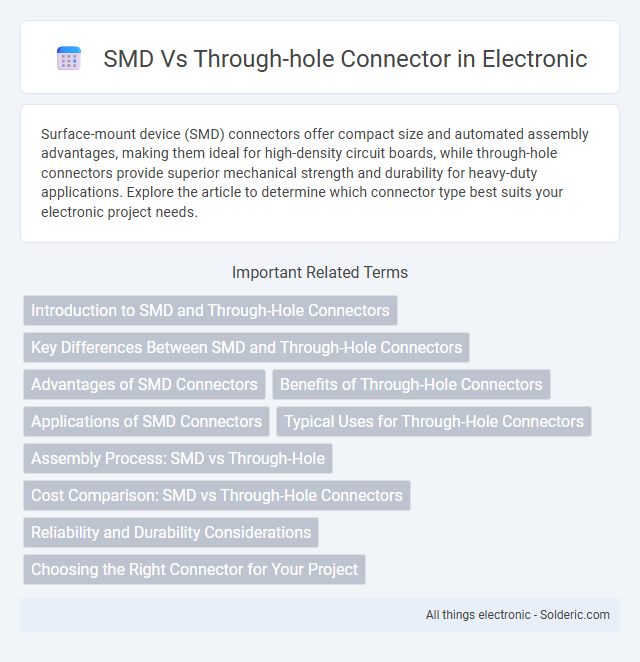Surface-mount device (SMD) connectors offer compact size and automated assembly advantages, making them ideal for high-density circuit boards, while through-hole connectors provide superior mechanical strength and durability for heavy-duty applications. Explore the article to determine which connector type best suits your electronic project needs.
Comparison Table
| Feature | SMD Connector | Through-hole Connector |
|---|---|---|
| Mounting Type | Surface Mount Device, soldered on PCB surface | Leads inserted through PCB holes and soldered |
| Size | Compact, saves PCB space | Larger, requires more PCB area |
| Mechanical Strength | Lower mechanical strength | Higher mechanical strength and durability |
| Assembly Process | Compatible with automated pick-and-place machines | Often manual or selective automated insertion |
| Signal Integrity | Suitable for high-frequency signals | Good but can introduce inductance through leads |
| Cost | Typically lower manufacturing cost | Potentially higher due to manual assembly |
Introduction to SMD and Through-Hole Connectors
SMD (Surface-Mount Device) connectors are designed for mounting directly onto the surface of PCBs, offering compact size and automated assembly advantages. Through-hole connectors feature leads that pass through PCB holes to provide strong mechanical bonds, ideal for components requiring durability. Your choice between SMD and through-hole connectors depends on assembly methods, mechanical strength needs, and PCB design constraints.
Key Differences Between SMD and Through-Hole Connectors
SMD connectors are mounted directly onto the surface of printed circuit boards (PCBs) using surface mount technology, enabling smaller, lighter designs and automated assembly processes. Through-hole connectors have leads that pass through holes in the PCB and are soldered on the opposite side, providing stronger mechanical bonds suitable for high-stress applications. Your choice between SMD and through-hole connectors depends on factors like board space, mechanical strength requirements, and manufacturing complexity.
Advantages of SMD Connectors
SMD connectors offer significant advantages such as a smaller footprint and lower profile, enabling more compact and lightweight designs ideal for modern electronics. Their automated assembly process increases manufacturing speed and reduces labor costs, enhancing production efficiency. You benefit from improved electrical performance and reliability due to shorter signal paths and minimized parasitic effects compared to through-hole connectors.
Benefits of Through-Hole Connectors
Through-hole connectors offer superior mechanical strength and reliability, making them ideal for applications that experience high stress or mechanical vibration. Their robust connection ensures better durability in harsh environments and is preferred for prototyping or equipment requiring frequent disassembly and reassembly. You benefit from enhanced electrical performance and easier inspection, which supports long-term maintenance and repair.
Applications of SMD Connectors
SMD connectors are widely used in compact electronic devices such as smartphones, laptops, and wearable technology due to their ability to be mounted directly onto the surface of PCBs, enabling smaller and lighter designs. Their applications extend to automotive electronics and medical devices, where reliable, space-saving interconnects are critical for maintaining performance under harsh conditions. High-frequency communication systems also benefit from SMD connectors because they offer excellent signal integrity and reduced parasitic inductance compared to through-hole connectors.
Typical Uses for Through-Hole Connectors
Through-hole connectors are commonly used in applications requiring robust mechanical strength, such as industrial equipment, automotive systems, and power supplies. Their reliable solder joint integrity makes them ideal for environments subject to vibration and mechanical stress. Your designs benefit from through-hole connectors when durability and secure mounting are critical factors.
Assembly Process: SMD vs Through-Hole
Surface-mount device (SMD) connectors enable automated, high-speed assembly with precise placement on PCB pads using pick-and-place machines, streamlining mass production and reducing labor costs. Through-hole connectors require manual or wave soldering processes where leads pass through drilled holes, offering stronger mechanical bonds ideal for high-stress applications but slower assembly times. Your choice impacts manufacturing efficiency, with SMD favoring compact, rapid assembly, while through-hole ensures durability in rugged environments.
Cost Comparison: SMD vs Through-Hole Connectors
SMD connectors generally offer lower manufacturing costs due to automated assembly processes and reduced material usage compared to through-hole connectors, which require more labor-intensive insertion and soldering. Your choice influences the overall budget since through-hole connectors typically incur higher expenses in production time and equipment maintenance. Cost efficiency of SMD connectors makes them ideal for high-volume electronics manufacturing where minimizing expenses is critical.
Reliability and Durability Considerations
Surface Mount Device (SMD) connectors offer superior reliability in high-frequency applications due to their minimized lead inductance and enhanced signal integrity, making them less prone to mechanical stress compared to Through-hole connectors. Through-hole connectors provide exceptional durability and robust mechanical strength, ideal for environments subject to vibration or frequent handling, as their leads are soldered through the PCB, ensuring strong physical anchoring. Your choice between SMD and Through-hole connectors should consider the operating conditions and mechanical demands to optimize long-term performance and reliability.
Choosing the Right Connector for Your Project
Selecting between SMD and through-hole connectors depends on your project's size, durability needs, and assembly method. SMD connectors offer compact footprints and are ideal for high-density circuit boards requiring automated placement, while through-hole connectors provide stronger mechanical bonds suitable for high-stress or high-vibration environments. Evaluating factors such as board space, mechanical stability, and production volume ensures optimal connector performance and reliability.
SMD vs Through-hole connector Infographic

 solderic.com
solderic.com